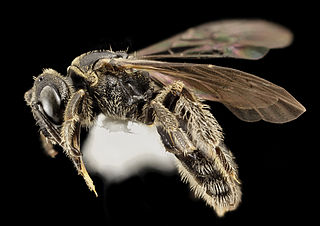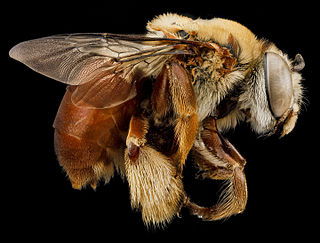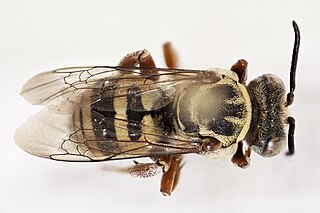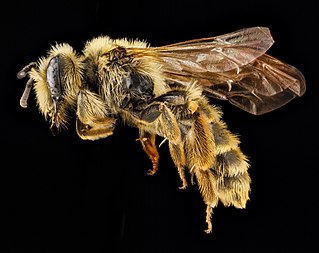
Pseudopanurgus is a genus of mining bees in the family Andrenidae. There are at least 130 described species in Pseudopanurgus. Pseudopanurgus bees often have 2 submarginal cells in their forewings. Their size range for extra-small to small, 3mm to 10mm
Oarisma edwardsii, or Edwards's skipperling, is a species of grass skipper in the family of butterflies known as Hesperiidae. It was first described by William Barnes in 1897 and it is found in Central and North America.

Centris errans, known generally as wandering centris, is a species of centridine bee in the family Apidae. Other common names include the Florida locust-berry oil-collecting bee and spiny bear's-breech. It is found in the Caribbean and North America. The species is one of five from the family Apidae that are endemic to the state of Florida. The species occurs the southernmost portion of Florida.
Xeromelecta interrupta, the interrupted xeromelectum, is a species of digger-cuckoo bee in the family Apidae. It is found in Central America and North America.

Melecta is a genus of digger-cuckoo bees in the family Apidae. There are at least 50 described species in Melecta.
Calliopsis linsleyi, or Linsley's nomadopsis, is a species of mining bee in the family Andrenidae. It is found in Central America and North America.
Paracosmus is a genus of bee flies in the family Bombyliidae. There are about five described species in Paracosmus.

Triepeolus martini is a species of cuckoo bee in the family Apidae. It is found in Central America and North America.

The European legume miner bee is a species of miner bee in the family Andrenidae. Its original distribution is Europe. It has been accidentally introduced to North America long ago, possibly with ship ballast. It is active between April and August. Nests singly in group aggregations. Preferentially collects pollen from clover and sweet clover (Fabaceae).
Melecta separata is a species of hymenopteran in the family Apidae. It is found in North America.

The death camas miner bee, is a species of miner bee in the family Andrenidae. Another common name for this species is death camas andrena. It is found in North America. It specialises in feeding on the highly poisonous Toxicoscordion venenosum and is possibly the only bee that can tolerate its toxins.
Eucera edwardsii is a species of long-horned bee in the family Apidae. It is found in Central America and North America.

Melecta pacifica is a species of hymenopteran in the family Apidae. It is found in North America.

The bumped miner bee is a species of miner bee in the family Andrenidae. Another common name for this species is the Nason's andrena. It is found in Central America and North America. It is a generalist, collects pollen from many different plants.
Paracosmus edwardsii is a species of bee flies in the family Bombyliidae.
Xeromelecta californica, the California xeromelectum, is a species of hymenopteran in the family Apidae. It is found in Central America and North America.

Ceratina calcarata, the spurred ceratina, is a species of carpenter bee in the family Apidae. It is found in eastern North America.
Nomada edwardsii, the Edwards' nomad bee, is a species of nomad bee in the family Apidae. It is found in Central America and North America.
Ptiloglossa mexicana, the Mexican feather-tongue, is a species of nocturnal bee in the family Colletidae. It is found from Central America north to Texas.
Hemipenthes edwardsii is a species of bee flies in the family Bombyliidae.







